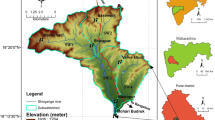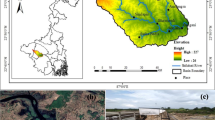Abstract
Subsurface water storage potential zone (SWSPz) is used as the source of water for household, agricultural, and industrial activities. The current study uses the integrated approach of geospatial, hydrogeological, and multi-criteria decision analysis (MCDA) based on the influencing parameter for subsurface water storage potential zones and its artificial recharge structure in western India's semi-arid watershed. The thematic map of the influencing parameter will be created using remote sensing data, secondary data, and maps of topography, lithology, drainage density, overland runoff, landform categorization, land use/land cover, type of soil, and vadose zone. The study's findings show that the region’s SWSPz is high in about 14.22% of the area, while groundwater recharge potential is intermediate in about 38.05% of the land and low in about 34.70% and 13.03% of poor the area, respectively. The study's validity was validated by superimposing groundwater level point data onto the final output map, which revealed a good accuracy with the findings. The CGWB approach was also utilized to analyze the surplus water availability, and the findings reveal a vadose area of 40.08 MCM with an artificial recharge of 53.31 MCM. Finally, to recharge the rainwater, suitable site was identified within the study area such as Check dam, Nala bund and percolation tank. The fourteen check dams were identified on third–fourth-order stream present at moderate to high storage potential zone. While twenty-three nala bunds and five percolation ponds were also identified in the study area, it showed good accuracy with ground truth data. In nutshell, to increase the subsurface water potential, the integrated geospatial and hydrogeological modeling approach will be useful for decision makers.












Similar content being viewed by others
Data Availability
All the available data for the study is included in the manuscript only.
References
Adham A, Sayl KN, Abed R, Abdeladhim MA, Wesseling JG, Riksen M, Fleskens L, Karim U, Ritsema CJ (2018) A GIS-based approach for identifying potential sites for harvesting rainwater in the Western desert of Iraq. Int Soil Water Conserv Res 6:297–304. https://doi.org/10.1016/j.iswcr.2018.07.003
Adimalla N (2018) Groundwater quality for drinking and irrigation purposes and potential health risks assessment: a case study from semi-arid region of South India. Exposure Health. https://doi.org/10.1007/s12403-018-0288-8
Amponsah PO, Forson ED, Sungzie PS et al (2022) Groundwater prospectivity modeling over the Akatsi Districts in the Volta region of Ghana using the frequency ratio technique. Model Earth Syst Environ. https://doi.org/10.1007/s40808-022-01539-8
Arya S, Subramani T, Karunanidhi D (2020) Delineation of groundwater potential zones and recommendation of artificial recharge structures for augmentation of groundwater resources in Vattamalaikarai Basin. South India Environ Earth Sci 79(5):1–13
Balamurugan G, Seshan K, Bera S (2017) Frequency ratio model for groundwater potential mapping and its sustainable management in cold desert. India J King Saud Univ Sci 29(3):333–347
CGWB (2006) Dynamic groundwater resource of Maharashtra. Central Groundwater Board, Nagpur
CGWB (2011) Dynamic groundwater resources of India. Central Ground Water Board, Ministry of Water Resources, New Delhi
Chowdhury A, Jha MK, Chowdary VM (2010) Delineation of groundwater recharge zones and identification of artificial recharge sites in West Medinipur district, West Bengal, using RS, GIS and MCDM techniques. Environ Earth Sci 59(6):1209–1222
Datta A, Gaikwad H, Kadam A, Umrikar BN (2020) Evaluation of groundwater prolific zones in the unconfined basaltic aquifers of Western India using geospatial modelling and MIF technique. Model Earth Syst Environ 6:1807–1821
Etuk MN, Igwe O, Egbueri JC (2022) An integrated geoinformatics and hydrogeological approach to delineating groundwater potential zones in the complex geological terrain of Abuja. Nigeria Model Earth Syst Environ. https://doi.org/10.1007/s40808-022-01502-7
Geological Survey of India (GSI) (2001) District Resource Map, Pune District, Maharashtra. India
Golla V (2020) Delineation of groundwater potential zones in Sathyavedu area, Chittoor District (Andhra Pradesh), South India, using geospatial technologies. Model Earth Syst Environ 6:895–905
Horton RE (1932) Drainage basin characteristics. Trans Amer Geophys Union 13:350–361
Jothibasu A, Anbazhagan S (2017) Spatial mapping of groundwater potential in Ponnaiyar River basin using probabilistic-based frequency ratio model. Model Earth Syst Environ 3(1):33
Kaliraj S, Chandrasekar N, Magesh NS (2014) Identification of potential groundwater recharge zones in Vaigai upper watershed, Tamil Nadu, using GIS-based analytical hierarchical process (AHP) technique. Arab J Geosci 7(4):1385–1401
Kom KP, Gurugnanam B, Sunitha V, Reddy YS, Kadam AK (2021) Hydrogeochemical assessment of groundwater quality for drinking and irrigation purposes in western Coimbatore, South India. Int J Energy Water Resour 6(4):475
Kumar A, Krishna AP (2018) Assessment off groundwater potential zones in coal mining impacted hard-rock terrain of India by integrating geospatial and analytic hierarchy process (AHP) approach. Geocarto Int 33(2):105–129
Kumar P, Thakur PK, Bansod BK, Debnath SK (2018) Groundwater: a regional resource and a regional governance. Environ Develop Sustain 20(3):1133–1151
Kumari A, Kumar D, Warwade P (2021).Application of multi-criteria decision making (MCDM) and electrical resistivity tomography (ERT) techniques for identification of groundwater recharge zone (s) in granitic hard rock aquifer. J Earth Syst Sci 130(2):1–17
Kumari S, Poddar A, Kumar N et al (2022) Delineation of groundwater recharge potential zones using the modeling based on remote sensing, GIS and MIF techniques: a study of Hamirpur District, Himachal Pradesh. India Model Earth Syst Environ 8:1759–1770. https://doi.org/10.1007/s40808-021-01181-w
Mandal U, Sahoo S (2016) Delineation of groundwater potential zones of coastal groundwater basin using multi criteria decision making technique. Water Resour Manag. https://doi.org/10.1007/s11269-016-1421-8
Mishra S, Tiwary D, Ohri A, Agnihotri AK (2019) Impact of municipal solid waste Landfillleachate on groundwater quality in Varanasi. India Groundwater Sustain Develop 9(10):1002–1030
Moges DM, Bhat HG, Thrivikramji KP (2019) Investigation of groundwater resources in highland Ethiopia using a geospatial technology. Model Earth Syst Environ 5(4):1333–1345
Omosuyi GO, Oshodi DR, Sanusi SO, Adeyemo IA (2020) Groundwater potential evaluation using geoelectrical and analytical hierarchy process modeling techniques in Akure-Owode, southwestern Nigeria. Model Earth Syst Environ 7(1):145–158
Omosuyi GO, Oshodi DR, Sanusi SO et al (2021) Groundwater potential evaluation using geoelectrical and analytical hierarchy process modeling techniques in Akure-Owode, southwestern Nigeria. Model Earth Syst Environ 7:145–158. https://doi.org/10.1007/s40808-020-00915-6
Owusu S, Mul ML, Ghansah B, Osei-Owusu PK, Awotwe-Pratt V, Kadyampakeni D (2017) Assessing land suitability for aquifer storage and recharge in northern Ghana using remote sensing and GIS multi-criteria decision analysis technique. Model Earth Syst Environ 3(4):1383–1393
Patra S, Mishra P, Mahapatra SC (2017) Delineation of groundwater potential zone for sustainable development: a case study from Ganga Alluvial Plain covering Hooghly district of India using remote sensing, geographic information system and analytic hierarchy process. J Cleaner Product 172:2485–2502
Rajasekhar M, Raju GS, Raju RS, Basha UI (2018) Data on artificial recharge sites identified by geospatial tools in semi-arid region of Anantapur District, Andhra Pradesh, India. Data Brief 19:1–13. https://doi.org/10.1016/j.dib.2018.04.050
Rajasekhar M, Sudarsana Raju G, Sreenivasulu Y, Raju RS (2019) Delineation of groundwater potential zones in semi-arid region of Jilledubanderu river basin, Anantapur District, Andhra Pradesh, India using fuzzy logic AHP and integrated fuzzy-AHP approaches. HydroResearch. 2(97):108
Rodell M, Famiglietti JS (2002) The potential for satellite-based monitoring of groundwater storage changes using GRACE: the high plains aquifer, central US. J Hydrol 263(1–4):245–256
Rodell M (2022) GRACE-FO Data Assimilation Applications and Issues (No. GSTM2022-18). Copernicus Meetings.
Roy S, Hazra S, Chanda A, Das S (2020) Assessment of groundwater potential zones using multi-criteria decision-making technique: a micro-level case study from red and lateritic zone (RLZ) of West Bengal India. Sustain Water Resour Manag. 6(1):14
Roy S, Bose A, Mandal G (2022) Modeling and mapping geospatial distribution of groundwater potential zones in Darjeeling Himalayan region of India using analytical hierarchy process and GIS technique. Model Earth Syst Environ 8:1563–1584. https://doi.org/10.1007/s40808-021-01174-9
Saaty TL (1980) The analytic hierarchy process: planning, priority setting, resource allocation. McGraw-Hill International Book Co., New York
Saaty TL (1990) How to make a decision the analytic hierarchy process. Eur J Oper Res 48(1):9–26
Saaty TL (2008) Decision making with the analytic hierarchy process. Int J Serv Sci 1(1):83–98
Saha S (2017) Groundwater potential mapping using analytical hierarchical process: a study on Md. bazar block of Birbhum district West Bengal. Spat Inf Res 25:615–626
Sahu U, Wagh V, Mukate S, Kadam A, Patil S (2022) Applications of geospatial analysis and analytical hierarchy process to identify the groundwater recharge potential zones and suitable recharge structures in the Ajani-Jhiri watershed of north Maharashtra India. Groundwater Sustain Develop 17:100733
Saranya T, Saravanan S (2020) Groundwater potential zone mapping using analytical hierarchy process (AHP) and GIS for Kancheepuram District, Tamilnadu India. Model Earth Syst Environ 6(2):1105
Selvam S, Sivasubramanian P (2012) Groundwater potential zone identification using geoelectrical survey: a case study from Medak district, Andhra Pradesh, India. Int J Geom Geosci 3(1):55–62
Shailaja G, Kadam AK, Gupta G, Umrikar BN, Pawar NJ (2018) Integrated geophysical, geospatial and multiple-criteria decision analysis techniques for delineation of groundwater potential zones in a semi-arid hard-rock aquifer in Maharashtra. India. Hydrogeol J 27(2):639–654
Singh LK, Jha MK, Chowdary VM (2017) Multi-criteria analysis and GIS modeling for identifying prospective water harvesting and artificial recharge sites for sustainable water supply. J Clean Prod. https://doi.org/10.1016/j.jclepro.2016.11.163
Singhai A, Das S, Kadam AK et al (2019) GIS-based multi-criteria approach for identification of rainwater harvesting zones in upper Betwa sub-basin of Madhya Pradesh, India. Environ Dev Sustain 21:777–797. https://doi.org/10.1007/s10668-017-0060-4
Thapa R, Gupta S, Guin S et al (2017) Assessment of groundwater potential zones using multi-influencing factor (MIF) and GIS: a case study from Birbhum district. West Bengal Appl Water Sci 7:4117–4131. https://doi.org/10.1007/s13201-017-0571-z
Yeh H-F, Cheng Y-S, Lin H-I, Lee C-H (2016) Mapping groundwater recharge potential zone using a GIS approach in Hualianriver. Taiwan Sustain Environ Res 26(1):33–43. https://doi.org/10.1016/j.serj.2015.09.005
Zaidi FK, Nazzal Y, Ahmed I, Naeem M, Jafri MK (2015) Identification of potential artificial groundwater recharge zones in Northwestern Saudi arabia using GIS and boolean logic. J African Earth Sci 111:156–169. https://doi.org/10.1016/j.jafrearsci.2015.07.008
Acknowledgements
First author is thankful to University Grants Commission Dr. D. S. Kothari Postdoctoral Fellowship Scheme (F.4-2/2006 (BSR)/ES/20-21/0004) for providing fellowship.
Author information
Authors and Affiliations
Corresponding author
Ethics declarations
Conflict of interest
The authors confirm that there are no known conflicts of interest associated with this publication.
Additional information
Publisher's Note
Springer Nature remains neutral with regard to jurisdictional claims in published maps and institutional affiliations.
Rights and permissions
Springer Nature or its licensor (e.g. a society or other partner) holds exclusive rights to this article under a publishing agreement with the author(s) or other rightsholder(s); author self-archiving of the accepted manuscript version of this article is solely governed by the terms of such publishing agreement and applicable law.
About this article
Cite this article
Kadam, A.K., Patil, S.N., Gaikwad, S.K. et al. Demarcation of subsurface water storage potential zone and identification of artificial recharge site in Vel River watershed of western India: integrated geospatial and hydrogeological modeling approach. Model. Earth Syst. Environ. 9, 3263–3278 (2023). https://doi.org/10.1007/s40808-022-01656-4
Received:
Accepted:
Published:
Issue Date:
DOI: https://doi.org/10.1007/s40808-022-01656-4




